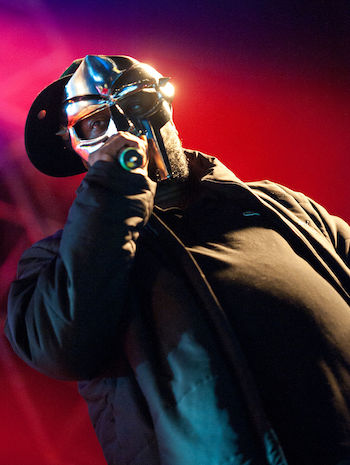Music Remembrance: MF DOOM — The Artist as Supervillain
By J. A. Bayer III
The sonic thumbprint of MF DOOM will live eternally in the forensics of hip-hop DNA and underground culture as a whole.
The Man

MF DOOM performing in 2011. Photo: Wiki Commons.
Daniel Dumile, the enigmatic and elusive linguist known as Zev Love X, Viktor Vaughn, King Geedorah, and most famously, MF DOOM, was born January 9, 1971, in London. His Trinidadian mother and Zimbabwean father soon emigrated from the UK and settled on Long Island, raising Daniel and his brother Dingilizwe in the Five-Percent Nation. This heavily Islam-influenced upbringing was an unmistakable influence on Daniel and Dingilizwe when, known as Zev Love X and DJ Subroc respectively, they formed their first hip-hop group KMD. After a show-stopping verse on the 3rd Bass hit 1989 single “The Gas Face,” KMD earned a recording contract of their own via Elektra Records. The debut effort, Mr. Hood, was released in 1991; it showcased the Afro-Centric themes and jazz-mining beats that had begun to boil up from the hip-hop underground via groups such as Brand Nubian and the Native Tongues collective.
The debut album achieved modest success in the growing landscape of early ’90s hip-hop, setting the table for a sophomore effort that — mired in controversy and tragedy — would not be heard until 2001. During the production of the album, DJ Subroc was killed crossing the Long Island Expressway, leaving Zev to complete the album alone. The result, titled Black Bastards, was a considerably darker musical carnival than its predecessor. The lyrical content and controversial album artwork led his record label to release the now grieving and forlorn young MC. His condition — alone, spurned, and spiraling out of the limelight — sowed the seeds of DOOM.
The Myth
Artistically destitute, Dumile remained ambitious and determined, though he reportedly was sleeping on park benches between New York and Atlanta. Immersing himself in the comic book/pop culture blender that had always fascinated him and his brother as children, Dumile emerged publicly, christening himself as MF DOOM, a name inspired by the Marvel comic villain Dr. Doom. Dr. Doom’s origin story resonates with Dumile’s trauma; the baddie becomes horribly disfigured after attempting to construct a machine to communicate with a dead loved one. At first, Dumile used women’s tights to obscure his face; soon the legendary DOOM mask, designed by graffiti artist Lord Scotch, became the mask heard ’round the world. Many have speculated about the need for the performer to be anonymous by way of the mask. DOOM was uncharacteristically open about why he donned a mask; it served as his critical reaction to what he saw as the over-commercialization of hip-hop music. The masquerade resisted sexual and commercial exploitation; it was also, importantly, his assertion of control over his performing persona, an independence that his earlier artistic ventures had undercut. His vocals, with their patented unmodulated flow, enriched by his thesaurus-swallowing wordplay, forced the listener to digest each syllable and couplet.
While mainstream contemporaries tend to make their money posting as the life of the party, each DOOM stanza is scattered with phonetic landmines, rewarding repeated listens because of their choose-your-own-adventure-style revelations. Reaching full artistic maturity, the newly minted MF DOOM’s second act was cemented by his debut album Operation: Doomsday, released in 1999, instantly catapulting the artist into the top tier of the late ’90s underground/backpack hip-hop renaissance. Doomsday would also set off the most prolific period of his album output: there was Take Me to Your Leader (credited to the alias King Geedorah), Vaudeville Villain, and Venomous Villain under the name Viktor Vaughn (Dr. Doom’s original name), and the genre-busting crossover juggernaut that was Madvillain (a collaboration with famed underground producer Madlib).
DOOM continued to wow critics and fans alike, bending the expectations and rules of rap music while developing a rabid cult following across the world. His Special Herbs instrumental series showcased his increasingly avant-garde chops as a producer and he teamed up with Danger Mouse for 2005’s The Mask and The Mouse. DOOM would go on to release only one more solo album after this period, 2009’s Born Like This, a considerably dark affair influenced by his growing obsession with the anarchistic writings of Charles Bukowski. As his releases became more sporadic, he continued to collaborate with other artists, including mainstream heavyweights such as Ghostface Killah, as well as independent upstarts Jneiro Jarel (Keys to the Kuffs) and Bishop Nehru (NehruvianDoom). After touring Europe in 2010, DOOM was denied access to return to the United States because he had (unknowingly) never become a “naturalized” citizen. Eventually he was able to move his family to Europe. He never returned to the US, stating “I’m over the United States.” In 2017, the Dubile family was struck with yet another tragedy when it was announced that DOOM’s 14-year-old son, King Malachi Ezekiel Dumas, had died.
The Legend
Dubile’s left-of-center rhyming patterns and self-mythologizing was an indispensable part of his outlaw attitude, as was his patented stubble and the metal DOOM mask. His death was announced December 31, 2020, via Instagram by his wife Jasmine. Keeping with the confounding legend of DOOM, it was revealed that he had actually “transitioned” months earlier, on October 31, 2020. Naturally, conspiracy theories abound. Is this one last Andy Kaufman-esque performance piece from the ultimate super villain, enemy of the industry that originally cast him aside, lurking in the shadows and laughing at his escape? Regardless of where he is now, the sonic thumbprint of DOOM is guaranteed to live eternally in the forensics of hip-hop DNA and underground culture as a whole.
“On Doomsday, ever since the womb,
’Til I’m back where my brother went,
that’s what my tomb will say
Right above my government; Dumile
Either unmarked or engraved, hey, who’s to say?”
Thanks to his prodigious output and penchant for grandiose peasant philosophizing — wordplay that drew from everywhere, dorm room and trap house, suburban cul-de-sac and alleyway — it will ALWAYS be DOOMSDAY somewhere in the world. ALL CAPS.
J. A. Bayer III is a front porch philosophy major and the founder of Infintesmal Records. He currently resides in Duval County, FL, with his wife, three dogs, and an army of feral cats.

